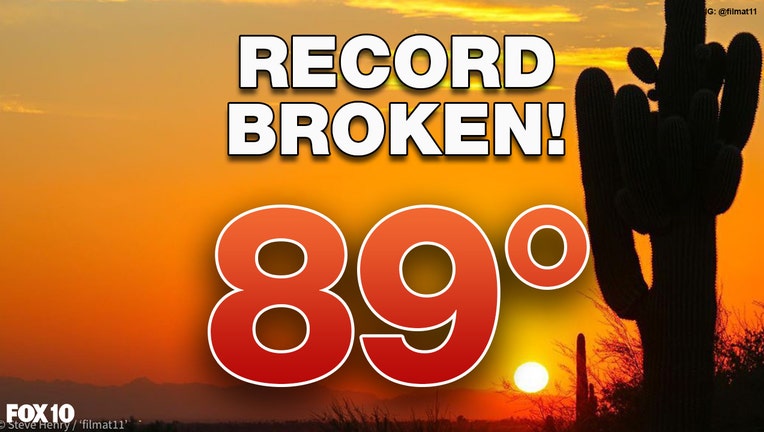Phoenix sees another day of record-breaking temperature; old 88°F record broken

PHOENIX - Phoenix has broken a temperature record set back in 2008, according to the National Weather Service.
According to the agency, Phoenix Sky Harbor Airport reached 89°F during the afternoon hours of Nov. 18.
The Valley has seen higher than usual temperatures in recent days, with record-breaking temperatures on Nov 16 and 17.
You can check the latest weather conditions by visiting the FOX 10 Phoenix weather page, or download the Free FOX 10 Weather app, which is available on Apple iOS and Android.
Preventing heat exhaustion/heat stroke
The Arizona Department of Health Services stated the following precautions can be taken to prevent heat exhaustion or heat stroke:
Stay in air-conditioned buildings
Limit outdoor activity during the hottest part of the day (mid-day)
Check on at-risk friends, family, and neighbors at least twice a day
Drink water before, during, and after working or exercising outside
Driving in extreme temperatures
The Arizona Department of Transportation’s tips for driving in extreme temperatures include:
Have sun protection: In addition to an umbrella, take sunscreen and a wide-brimmed hat and wear loose-fitting, light-colored cotton clothing.
Fuel up: Keep your tank at three-quarters full. Running out of gas, especially in a remote location, is dangerous in extreme heat.
Hydrate: Take a cooler to keep extra drinking water cold, and consider adding several frozen bottles of water to use for cooling off or to thaw and drink if needed. Make sure everyone, including pets, stays hydrated.
Get help: If your vehicle breaks down in extreme heat, call for assistance right away to reduce wait time, and run the AC. If the AC isn’t working, roll down all windows.
Wait safely: If the temperature inside your vehicle becomes too hot, everyone, including pets, should exit carefully and seek out or create a shaded area as far away from the travel lanes as possible. Be careful walking on the road surface, which can be hot enough to burn skin. Keep your shoes on and try to keep your pets’ paws off the pavement. If you are stopped along the highway, raise the front hood and turn on hazard lights. Please keep in mind that parking in tall brush can start a fire.
Check your vehicle: You can help avoid breakdowns and blowouts by making sure your vehicle is in good operating condition. Check your air conditioner and coolant levels, top off any vital engine fluids and make sure your battery is up to par. Check your tire pressure, as the combination of under inflated tires and hot pavement can lead to a blowout.
MORE: https://azdot.gov/about/transportation-safety/severe-weather
Rain/flood safety tips
The American Red Cross' tips for heavy rain situations and flood safety:
Turnaround don’t drown! If you must drive and you encounter a flooded roadway, turn around and go another way.
If you are caught on a flooded road and waters are rising rapidly around you, get out of the car quickly and move to higher ground.
Tune in to your local radio, NOAA radio, or news channels for the latest updates.
If your neighborhood is prone to flooding, be prepared to evacuate quickly.
Follow evacuation orders and do not attempt to return until officials say it is safe.
If power lines are down, do not step in puddles or standing water.
If power is out, use a flashlight. Do not use any open flame as alternate lighting.
Preparing for a severe thunderstorm
The American Red Cross' tips for preparing for a severe thunderstorm:
Put together an emergency kit.
Know your community’s evacuation plan.
Create a household disaster plan and practice it.
Purchase a battery-powered or hand-crank radio
Discuss thunderstorm safety with members of your household. Be aware that a thunderstorm could produce flooding.
Pick a safe place in your home for household members to gather during a thunderstorm. This should be a place where there are no windows, skylights, or glass doors, which could be broken by strong winds or hail and cause damage or injury.

